Lenovo 4155, 4158, 4218 User Manual
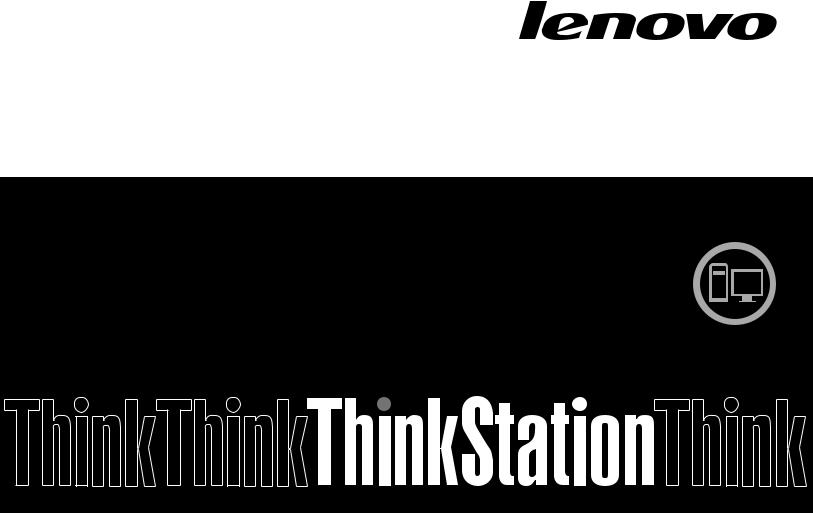
ThinkStation
User Guide
Machine Types: 4155, 4158, and 4218

ThinkStation
User Guide

Note
Before using this information and the product it supports, be sure to read and understand the ThinkStation Safety and Warranty Guide that came with this product and Appendix C, “Notices,” on page 61.
Second Edition (October 2009)
© Copyright Lenovo 2009.
LENOVO products, data, computer software, and services have been developed exclusively at private expense and are sold to governmental entities as commercial items as defined by 48 C.F.R. 2.101 with limited and restricted rights to use, reproduction and disclosure.
LIMITED AND RESTRICTED RIGHTS NOTICE: If products, data, computer software, or services are delivered pursuant a General Services Administration ″GSA″ contract, use, reproduction, or disclosure is subject to restrictions set forth in Contract No. GS-35F-05925.

Contents
Introduction . . . . . . . . . . . . . v
Chapter 1. Important safety information 1
Chapter 2. Arranging your workspace . . 3
Comfort . . . . . . . . . . . . . . . |
. |
3 |
Glare and lighting . . . . . . . . . . . |
. |
3 |
Air circulation . . . . . . . . . . . . . |
. |
4 |
Electrical outlets and cable lengths . . . . . . |
. |
4 |
Chapter 3. Setting up your computer . |
. 5 |
|
Connecting your computer . . . . . . . . |
. |
5 |
Turning on computer power . . . . . . . . |
. 12 |
|
Finishing the software installation . . . . . . |
. |
12 |
Completing important tasks . . . . . . . . |
. |
12 |
Updating your operating system . . . . . . |
. 13 |
|
Installing other operating systems . . . . . . |
. |
13 |
Updating your antivirus software . . . . . . |
. |
13 |
Shutting down the computer . . . . . . . |
. 13 |
|
Installing external options . . . . . . . . |
. |
13 |
Installing the computer on a rack shelf . . . . |
. |
14 |
Features . . . . . . . . . . . . . . |
. |
14 |
Specifications . . . . . . . . . . . . . |
. |
17 |
Chapter 4. Software overview . . . . . 19
Software provided with your Windows operating system . . . . . . . . . . . . . . . . 19
Software provided by Lenovo . . . . . |
. |
. 19 |
|
Lenovo ThinkVantage Toolbox . . . . . |
. |
. 20 |
|
Lenovo System Toolbox . . . . . . . |
. |
. |
20 |
PC-Doctor for Rescue and Recovery . . . |
. |
. 20 |
|
Adobe Reader . . . . . . . . . . |
. |
. |
20 |
Chapter 5. Using the Setup Utility . . . 21
Starting the Setup Utility program. . . . . . . 21 Viewing and changing settings . . . . . . . . 21 Using passwords . . . . . . . . . . . . 21 Password considerations . . . . . . . . . 22 User Password . . . . . . . . . . . . 22 Administrator Password . . . . . . . . . 22 Setting, changing, and deleting a password. . . 22 Enabling or disabling a device . . . . . . . . 23 Selecting a startup device. . . . . . . . . . 23 Selecting a temporary startup device . . . . . 23 Selecting or changing the startup device sequence 24 Advanced settings . . . . . . . . . . . . 24 Exiting from the Setup Utility program . . . . . 24
Chapter 6. Installing hard disk drives
and configuring RAID . . . . . . . . 25
Installing SATA or SAS hard disk drives and configuring RAID . . . . . . . . . . . . 25
Installing SATA or SAS hard disk drives. . . . 25
Entering the Marvell BIOS Setup to configure |
|
|
SATA or SAS RAID. . . . . . . . . . |
. |
25 |
Configuring the Marvell BIOS Setup to enable |
|
|
SATA or SAS RAID 0, 1, 5, or 10 functionality . |
. 26 |
|
Configuring the Marvell BIOS Setup to set an |
|
|
optional hot spare hard disk drive. . . . . |
. |
26 |
Configuring the Marvell BIOS Setup to delete an |
|
|
optional hot spare hard disk drive. . . . . |
. |
26 |
Configuring the Marvell BIOS Setup to delete an |
|
|
array . . . . . . . . . . . . . . |
. |
27 |
Chapter 7. Updating system programs |
29 |
Using system programs . . . . . . . . . |
. 29 |
Updating (flashing) BIOS from a disc. . . . . |
. 29 |
Updating (flashing) BIOS from your operating
system . . . . . . . . . . . . . . . . 30 Recovering from a POST/BIOS update failure . . . 30
Chapter 8. Troubleshooting and diagnostics . . . . . . . . . . . . . 33
Basic troubleshooting . . . . . . . . . . |
. |
33 |
Diagnostic programs . . . . . . . . . . |
. |
34 |
Lenovo ThinkVantage Toolbox . . . . . . |
. 35 |
|
Lenovo System Toolbox . . . . . . . . |
. |
35 |
PC-Doctor for Rescue and Recovery . . . . |
. 35 |
|
PC-Doctor for DOS . . . . . . . . . . |
. |
36 |
Cleaning the mouse . . . . . . . . . . |
. |
37 |
Optical mouse . . . . . . . . . . . |
. |
37 |
Non-optical mouse . . . . . . . . . . |
. |
37 |
Chapter 9. Recovery information |
. . |
. |
39 |
Creating and using recovery media . . . |
. . |
. 39 |
|
Creating recovery media . . . . . . |
. . |
. |
39 |
Using recovery media . . . . . . . |
. . |
. |
40 |
Performing backup and recovery operations |
. . |
. 40 |
|
Performing a backup operation . . . . |
. . |
. 41 |
|
Performing a recovery operation . . . |
. . |
. |
41 |
Using the Rescue and Recovery workspace . . . . 42
Creating and using rescue media . . . . . |
. |
. 43 |
|
Creating rescue media . . . . . . . . |
. |
. |
43 |
Using rescue media. . . . . . . . . |
. |
. |
44 |
Creating and using a recovery repair diskette . |
. |
. 44 |
|
Creating a recovery repair diskette . . . |
. |
. |
44 |
Using a recovery repair diskette . . . . |
. |
. |
45 |
Installing or reinstalling device drivers . . . |
. |
. |
45 |
Setting a rescue device in the startup sequence |
. |
. 46 |
|
Solving recovery problems . . . . . . . |
. |
. |
46 |
Chapter 10. Getting information, help,
and service . . . . . . . . . . . . . 47
Information resources . . . . . . |
. . . |
. |
. |
47 |
Online Books folder . . . . . |
. . . |
. |
. |
47 |
Lenovo ThinkVantage Tools . . . |
. . . |
. |
. |
47 |
Lenovo Welcome . . . . . . |
. . . |
. |
. |
47 |
© Copyright Lenovo 2009 |
iii |
Safety and Warranty . . . . . . . . |
. |
. |
48 |
Lenovo Web site (http://www.lenovo.com). |
. |
. 48 |
|
Help and service . . . . . . . . . . |
. |
. |
48 |
Using the documentation and diagnostic
programs . . . . . . . . . . . . . . 48
Calling for service . . . . . |
. . |
. |
. . |
. |
48 |
Using other services . . . . |
. . |
. |
. . |
. |
49 |
Purchasing additional services . |
. . |
. |
. . |
. |
50 |
Appendix A. Manual modem
commands . . . . . . . . . . . . . 51
Basic AT commands . . . . . . . . . |
. |
. |
51 |
Extended AT commands . . . . . . . . |
. |
. 53 |
|
MNP/V.42/V.42bis/V.44 commands . . . . |
. |
. |
54 |
Fax Class 1 |
commands |
. . . . . |
. |
. . |
. |
. |
55 |
Fax Class 2 |
commands |
. . . . . |
. |
. . |
. |
. |
55 |
Voice commands. . . |
. . . . . |
. |
. . |
. |
. |
56 |
|
Appendix B. System memory speed . . 59
Appendix C. Notices . . . . . . . . . 61
Television output notice . . . . . . . . . . 62 European conformance CE mark . . . . . . . 62 Trademarks . . . . . . . . . . . . . . 62
Index . . . . . . . . . . . . . . . 63
iv User Guide

Introduction
This ThinkStation User Guide contains the following information:
vChapter 1, “Important safety information,” on page 1 provides information about where to find safety information for this product.
vChapter 2, “Arranging your workspace,” on page 3 provides information about setting up your computer for comfort and the impact of light sources, air circulation, and electrical outlets.
vChapter 3, “Setting up your computer,” on page 5 provides information about setting up your computer, and also installing the operating system and other software.
vChapter 4, “Software overview,” on page 19 provides information on the operating system and software applications that might be preloaded on your computer.
vChapter 5, “Using the Setup Utility,” on page 21 provides instructions on how to view and change the configuration settings of your computer.
vChapter 7, “Updating system programs,” on page 29 provides information about updating POST/BIOS and how to recover from a POST/BIOS update failure.
vChapter 8, “Troubleshooting and diagnostics,” on page 33 provides information about basic troubleshooting and diagnostic tools for your computer.
vChapter 9, “Recovery information,” on page 39 provides instructions on how to use the ThinkVantage® Rescue and Recovery® program to create product recovery discs, back up data, recover software, and restore the entire contents of your hard disk drive to a previously saved state.
vChapter 10, “Getting information, help, and service,” on page 47 provides information on the wide variety of helpful resources available from Lenovo®.
vAppendix A, “Manual modem commands,” on page 51 provides commands for manually programming your modem.
vAppendix B, “System memory speed,” on page 59 provides information on the supported system memory speed for your computer model.
vAppendix C, “Notices,” on page 61 provides notices and trademark information.
© Copyright Lenovo 2009 |
v |
vi User Guide

Chapter 1. Important safety information
CAUTION:
Before using this manual, be sure to read and understand all the related safety information for this product. Refer to the ThinkStation Safety and Warranty Guide that you received with this product for the latest safety information. Reading and understanding this safety information reduces the risk of personal injury and or damage to your product.
If you no longer have a copy of the ThinkStation Safety and Warranty Guide, you can obtain one online from the Lenovo Support Web site at: http://www.lenovo.com/support
CAUTION:
ThinkStation™ machine types 4155, 4158, and 4218 each weigh approximately 26 kg (57 lbs). For personal safety, it is recommended that two people lift and or carry these computers.
© Copyright Lenovo 2009 |
1 |
2 User Guide

Chapter 2. Arranging your workspace
To get the most from your computer, arrange both the equipment you use and your work area to suit your needs and the kind of work you do. Your comfort is of foremost importance, but light sources, air circulation, and the location of electrical outlets can also affect the way you arrange your workspace.
Comfort
Although no single working position is ideal for everyone, here are a few guidelines to help you find a position that suits you best.
Sitting in the same position for a long time can cause fatigue. The backrest and seat of your chair should adjust independently and provide good support. The seat should have a curved front to relieve pressure on the thighs. Adjust the seat so that your thighs are parallel to the floor and your feet are either flat on the floor or on a footrest.
When using the keyboard, keep your forearms parallel to the floor and your wrists in a comfortable position. Use a light touch on the keyboard and your hands and fingers relaxed. Change the angle of the keyboard for maximum comfort by adjusting the position of the keyboard feet.
Viewing Distance
Lower
Back
Support
Seat
Height
Adjust the monitor so the top of the screen is at, or slightly below, eye level. Place the monitor at a comfortable viewing distance, usually 51 to 61 cm (20 to 24 inches), and position it so you can view it without having to twist your body. Also, position other equipment you use regularly, such as the telephone or a mouse, within easy reach.
Glare and lighting
Position the monitor to minimize glare and reflections from overhead lights, windows, and other light sources. Reflected light from shiny surfaces can cause annoying reflections on your monitor screen. Place the monitor at right angles to windows and other light sources, when possible. Reduce overhead lighting, if necessary, by turning off lights or using lower wattage bulbs. If you install the monitor near a window, use curtains or blinds to block the sunlight. You can adjust the brightness and contrast controls on the monitor as the room lighting changes throughout the day.
© Copyright Lenovo 2009 |
3 |

Where it is impossible to avoid reflections or to adjust the lighting, an antiglare filter placed over the screen might be helpful. However, these filters might affect the clarity of the image on the screen; try them only after you have exhausted other methods of reducing glare.
Dust buildup compounds problems associated with glare. Remember to clean your monitor screen periodically using a soft cloth as directed in your monitor documentation.
Air circulation
Your computer and monitor produce heat. The computer has a fan that pulls in fresh air and forces out hot air. The monitor lets hot air escape through vents. Blocking the air vents can cause overheating, which might result in a malfunction or damage. Place the computer and monitor so that nothing blocks the air vents; usually, 51 mm (2 inches) of air space is sufficient. Also, make sure the vented air is not blowing on people.
Electrical outlets and cable lengths
The location of electrical outlets, the length of power cords and cables that connect to the monitor, printer, and other devices might determine the final placement of your computer.
When arranging your workspace:
vAvoid the use of extension cords. When possible, plug the computer power cord directly into an electrical outlet.
vKeep power cords and cables neatly routed away from walkways and other areas where they might get kicked accidentally.
For more information about power cords, refer to the ThinkStation Safety and
Warranty Guide that came with your computer.
4 User Guide
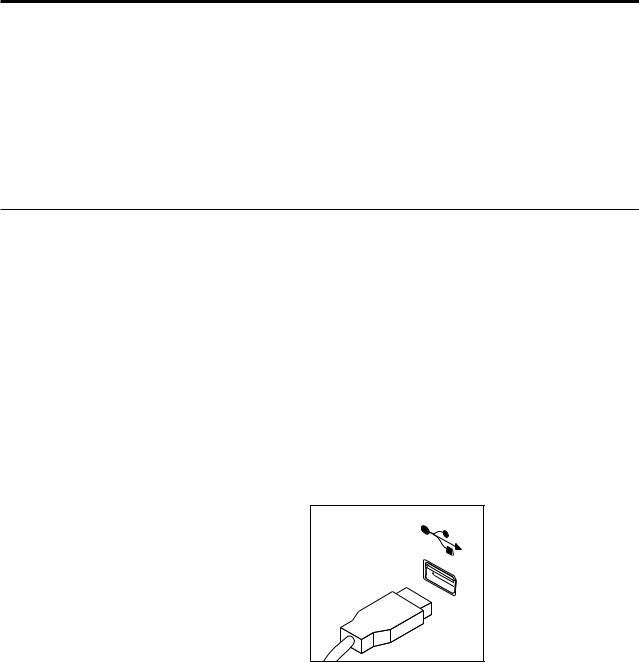
Chapter 3. Setting up your computer
Be sure to read and understand the ThinkStation Safety and Warranty Guide before you set up your computer. Reading and understanding the safety information reduces the risk of personal injury and or damage to your product.
Set up your computer in the best possible work area that suits your needs and the kind of work you do. For more information, see Chapter 2, “Arranging your workspace,” on page 3.
Connecting your computer
Use the following information when connecting your computer.
vLook for the small connector icons on the back of your computer. Match the connectors to the icons.
vIf your computer cables and connector panel have color-coded connectors, match the color of the cable end with the color of the connector. For example, match a blue cable end with a blue connector or a red cable end with a red connector.
Notes:
1.Depending on your model type, your computer might not have all the connectors that are described in this section.
2.Your computer automatically detects the voltage and sets the power supply to the correct setting.
To connect your computer, do the following:
1. Connect the Universal Serial Bus (USB) keyboard cable to the USB connector.
Note: Some models will have keyboards with a fingerprint reader.
© Copyright Lenovo 2009 |
5 |
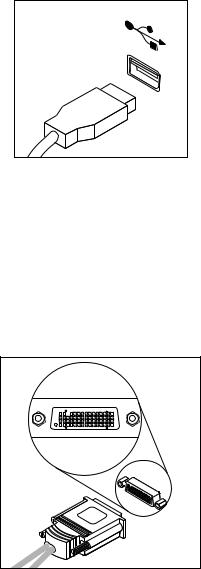
2. Connect the USB mouse cable to the USB connector.
3.Connect the monitor cable to the monitor connector.
Note: Depending on your model type, your computer might come with a Low Force Helix (LFH) connector on the rear panel, which enables you to connect up to four monitors. The standard LFH connector has two breakout Video Graphics Array (VGA) cables or Digital Video Interface (DVI) cables. This solution provides you with flexibility for a variety of monitor configurations. To use the LFH connector, your computer must have a graphics card with multi-monitor capabilities. Connect the breakout cables to the LFH connector as shown, then connect the VGA or DVI cables to the breakout cables.
6 User Guide

4. If you have a modem, connect the modem using the following information.
PHONE
LINE
PHONE |
|
PHONE |
|
LINE |
|
PHON |
E |
|
|
LINE |
|
LINE |
|
1 This illustration shows the two connectors on the back of the computer that are needed to set up your modem.
2 In the United States and other countries or regions that use the RJ-11 telephone outlet, attach one end of the telephone cable to the telephone and the other end to the telephone connector on the back of the computer. Attach one end of the modem cable to the modem connector on the back of the computer and the other end to the telephone outlet.
3 In countries or regions that do not use RJ-11 telephone outlets, a splitter or converter is required to attach the cables to the telephone outlet, as shown at the top of the illustration. You can also use the splitter or converter without the telephone, as shown at the bottom of the illustration.
Chapter 3. Setting up your computer 7
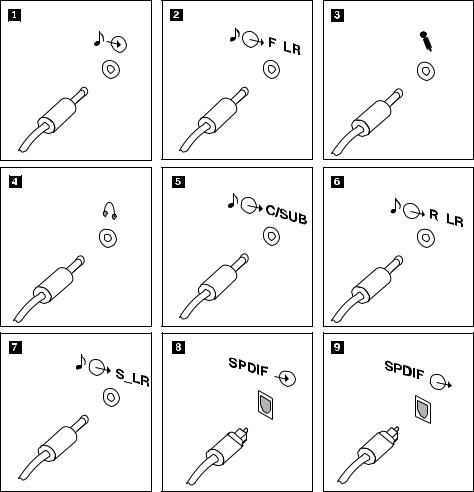
5.If you have audio devices, attach them using the following instructions. For more information about speakers, see step 6 and step 7 on page 10.
8 User Guide
1 Audio line-in connector |
Used to receive audio signals from an external audio |
|
device, such as a stereo system. When you attach an |
|
external audio device to your computer, connect the |
|
cable to the audio line-out connector of the device and |
|
the audio line-in connector of the computer. |
2 Audio line-out connector |
Used to send audio signals from the computer to |
(front speaker connector) |
external audio devices, such as powered stereo speakers |
|
(speakers with built-in amplifiers), multimedia |
|
keyboards, or the audio line-in connector on a stereo |
|
system or other external recording devices. |
|
When used with 5.1 or 7.1 surround speakers, this |
|
connector should be attached to the front left and right |
|
speakers. |
3 Microphone connector |
Used to attach a microphone to your computer when |
|
you want to record sound or if you use |
|
speech-recognition software. |
4 Headphone connector |
Used to attach headphones to your computer when you |
|
want to listen to music or other sounds without |
|
disturbing anyone. This connector might be located on |
|
the front of the computer. |
5 Audio line-out connector (subwoofer/center speaker connector)
6 Audio line-out connector (rear speaker connector)
7 Audio line-out connector (side speaker connector)
8 Optical SPDIF (Sony Philips Digital Interconnect Format) in connector
9 Optical SPDIF out connector
When used with 5.1 or 7.1 surround speakers, this connector should be attached to the center speaker and subwoofer.
When used with 5.1 or 7.1 surround speakers, this connector should be attached to the rear left and right speakers.
When used with 7.1 surround speakers, this connector should be attached to the side left and right speakers.
Used to receive 5.1 digital audio signals from an external device, such as a receiver or other multimedia devices, through a TOSLINK (ToshibaLink) optical cable.
Used to send 5.1 digital audio signals from a computer to an external device, such as an amplifier or a receiver, through a TOSLINK optical cable.
Chapter 3. Setting up your computer 9
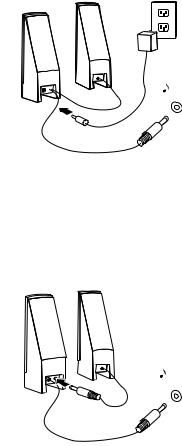
6. If you have powered speakers with an ac power adapter:

 F_LR
F_LR
a.Connect the cable that runs between the speakers, if necessary. On some speakers, this cable is permanently attached.
b.Connect the ac power adapter cable to the speaker.
c.Connect the speakers to the computer.
d.Connect the ac power adapter to the ac power source.
7.If you have unpowered speakers with no ac power adapter:

 F_LR
F_LR
a.Connect the cable that runs between the speakers, if necessary. On some speakers, this cable is permanently attached.
b.Connect the speakers to the computer.
10 User Guide

8.Connect any additional devices that you have. Your computer might not have all connectors that are shown.
1394 |
1394 |
1 USB connector |
Used to attach a device that requires a Universal Serial Bus (USB) |
|
connector, such as a USB keyboard, a USB mouse, a USB scanner, or a |
|
USB printer. If you have more than 10 USB devices, you can purchase |
|
a USB hub, which you can use to connect additional USB devices. |
2 Serial port |
Used to attach an external modem, a serial printer, or other devices |
|
that use a 9-pin serial port. |
3 Ethernet |
Used to attach an Ethernet cable for a local area network (LAN). |
connector |
Notes: |
|
1.To operate the computer within FCC Class B limits, use a Category 5 Ethernet cable.
2.Your computer has two Ethernet connectors. For optimal performance, connect your Ethernet cable for the primary LAN to the connector marked as number ″1.″
4 IEEE 1394 Used to send and receive IEEE 1394 signals between the computer connector and other compliant devices, such as a video camera or an external
storage drive. This connector is sometimes called Firewire.
5 eSATA |
Use this External Serial Advanced Technology Attachment (eSATA) |
connector |
connector to attach an external hard disk drive. |
Chapter 3. Setting up your computer 11

9. Connect the power cords to properly grounded electrical outlets.
Turning on computer power
Turn on the monitor and other external devices first, and then turn on the computer. When the power-on self-test (POST) is finished, the logo window closes. If your computer has preinstalled software, the software installation program starts.
If you experience any problems during startup, refer to Chapter 10, “Getting information, help, and service,” on page 47. You can get additional help and information by telephone through the Customer Support Center. For the latest Service and Support worldwide telephone list, go to: http://www.lenovo.com/support
Finishing the software installation
Important
Be sure to read and understand the license agreements carefully before using the programs on this computer. These agreements detail your rights, obligations, and warranties for the software programs on this computer. By using these programs, you accept the terms of the agreements. If you do not accept the agreements, do not use the programs. Instead, promptly return the entire computer for a full refund.
The first time you start your computer, follow the instructions on the screen to complete the software installation. If you do not complete the software installation the first time the computer is turned on, unpredictable results might occur.
Note: Some models might have a multilingual version of Microsoft® Windows® operating system preinstalled. If your computer has the multilingual version, you will be prompted to choose a language during the installation process. After installation, the language version can be changed through the Windows Control Panel.
Completing important tasks
After you have set up your computer, perform the following tasks, which could save you time and trouble in the future:
vCreate a diagnostic CD/DVD image or rescue medium. Diagnostic programs are used to test hardware components of your computer and report operating-system-controlled settings that can cause hardware failures. Making a
12 User Guide

diagnostic CD/DVD image or rescue medium beforehand assures that you will be able to run diagnostics if the Rescue and Recovery workspace becomes inaccessible. See “PC-Doctor for DOS” on page 36 and “Creating and using rescue media” on page 43 for more information.
vRecord your computer machine type, model, and serial number. If you need service or technical support, you will probably be asked for this information. For further information, refer to the safety and warranty information that is provided with your computer.
Updating your operating system
Microsoft makes updates available for various operating systems through the Microsoft Windows Update Web site. The Web site automatically determines what Windows updates are available for your specific computer and lists those updates only. Updates could include security fixes, new versions of Windows components (such as media player), fixes to other portions of the Windows operating system, or enhancements.
Installing other operating systems
If you want to install your own operating system rather than the operating system preinstalled, follow the instructions that come with your operating system discs or diskettes. Remember to install all device drivers after you have installed the operating system. You can find the device drivers together with the installation instructions for ThinkStation at:
http://www.lenovo.com/support
Updating your antivirus software
Your computer comes with antivirus software that you can use to detect and eliminate viruses. Lenovo provides a full version of antivirus software on your hard disk drive with a free 30-day subscription. After 30 days, you must renew the license to continue receiving the antivirus program updates.
Shutting down the computer
When you turn off your computer, always follow the shutdown procedure for your operating system. This prevents the loss of unsaved data or damage to your software programs.
vTo shut down the Microsoft Windows 7 operating system, open the Start menu from the Windows desktop and click Shut down.
vTo shut down the Microsoft Windows Vista® operating system, open the Start menu from the Windows desktop, move the cursor to the arrow next to the lock workstation button, and select Shut Down.
vTo shut down the Microsoft Windows XP operating system, open the Start menu from the Windows desktop and click Shut Down. Then, select Shut down from the drop-down list box and click OK.
Installing external options
For information about installing external options for your computer, refer to “Installing external options” in the ThinkStation Hardware Installation and Replacement Guide.
Chapter 3. Setting up your computer 13

Installing the computer on a rack shelf
Your ThinkStation computer can be used on a rack shelf. When installing the computer on a rack shelf, make sure to leave at least a 12.7 cm (5 inches) space between the front edge of the rack shelf and your computer for fire protection.
Features
This section provides an overview of the computer features.
System information
The following information covers a variety of models. For information about your specific model, use the Setup Utility. See Chapter 5, “Using the Setup Utility,” on page 21.
Microprocessor
vIntel® Xeon® Quad Core
vIntel Xeon Dual Core
vInternal cache (size varies by model type)
Memory
vSupports up to 12 DDR3 ECC UDIMMs
(double data rate 3 error correction code unbuffered dual inline memory modules)
or DDR3 ECC RDIMMs
(double data rate 3 error correction code registered dual inline memory modules)
vEach microprocessor supports up to six memory modules
Note: The Intel Xeon microprocessor families compatible with this ThinkStation computer feature an integrated memory controller, which provides the microprocessor with direct access to the system memory. Because of this design, the system memory speed will be determined by a number of factors, including the microprocessor model and the type, speed, size (capacity), and number of DIMMs installed. Refer to Appendix B, “System memory speed,” on page 59 for the information on the supported system memory speed for your own computer model.
Internal drives
v3.5-inch standard half-high diskette drive (optional)
vCard reader (optional)
vSerial Advanced Technology Attachment (SATA) internal hard disk drive or Serial attached SCSI (SAS) internal hard disk drive
vOptical drive
Video subsystem
v Graphics card (varies by model type)
Audio subsystem
vIntegrated high-definition (HD) audio
vHeadphone connector and microphone connector on the front panel
14 User Guide
vEight audio connectors on the rear panel (audio line-in connector, audio line-out front speaker connector, microphone connector, audio line-out subwoofer/center speaker connector, audio line-out rear speaker connector, audio line-out side speaker connector, optical SPDIF in connector, and optical SPDIF out connector)
vInternal speaker
Connectivity
vTwo 10/100/1000 Mbps integrated Ethernet connectors
vPeripheral Component Interconnect (PCI) V.90 Data/Fax modem (some models)
System management features
vAbility to store POST hardware test results
vAlert Standard Format (ASF) 2.0
vAutomatic power-on startup
vPreboot Execution Environment (PXE)
vRemote Administration
vSystem Management (SM) Basic Input/Output System (BIOS) and SM software
vWake on LAN
vWake on Ring (in the Setup Utility program, this feature is called Serial Port Ring Detect for an external modem)
Input/Output (I/O) features
v9-pin serial port
vUSB connectors (eight rear and two front)
vTwo Ethernet connectors
vTwo IEEE 1394 connectors (one on the front panel and one on the rear panel)
veSATA connector
vVGA or DVI monitor connector (requires video card)
vEight audio connectors on the rear panel (audio line-in connector, audio line-out front speaker connector, microphone connector, audio line-out subwoofer/center speaker connector, audio line-out rear speaker connector, audio line-out side speaker connector, optical SPDIF in connector, and optical SPDIF out connector)
vTwo audio connectors on the front panel (microphone connector and headphone connector)
Expansion
vThree optical drive bays
vOne drive bay for either a 3.5-inch diskette drive or a card reader
vTwo 32-bit PCI card slots
vOne PCI Express x1 card slot
vOne PCI Express x4 card slot (mechanical x16)
vTwo PCI Express 2.0 x16 card slots
vFive hard disk drive bays
Power
v1060-watt auto-sensing power supply
vAutomatic 50/60 Hz input frequency switching
vAdvanced Configuration and Power Interface (ACPI) support
Chapter 3. Setting up your computer 15
